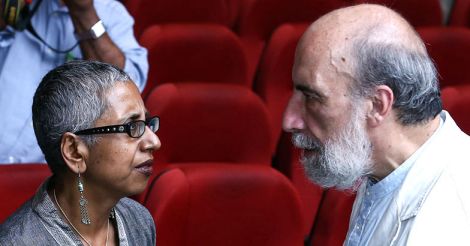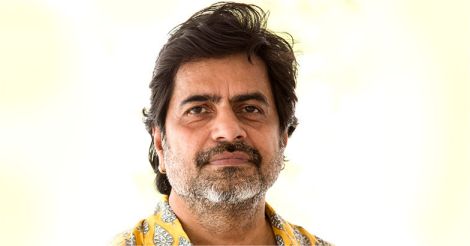Kochi: The third edition of Kochi-Muziris Biennale (KMB) will feature internationally-reputed writers, musicians and theatre-persons along with a host of visual artistes from across India and the world. Among them will figure iconic Chilean poet Raul Zurita, who was announced as the first artist at KMB’16 on December 15, 2015.
The upcoming Biennale will host works by artists working across a range of media – in keeping with its mandate to broaden and blur the labels and lines attributed to art, according to KMB’16 curator Sudarshan Shetty.
“It is going to be an admixture of styles, schools and sensibilities,” said Shetty, long recognised as one of his generation’s most innovative artists.
 Iconic Chilean poet-revolutionary Raul Zurita and noted writer Sharmistha Mohanty (L) are among the first 25 artists participating in the Kochi-Muziris Biennale 2016.
Iconic Chilean poet-revolutionary Raul Zurita and noted writer Sharmistha Mohanty (L) are among the first 25 artists participating in the Kochi-Muziris Biennale 2016.Shetty was unanimously chosen as curator by an artistic advisory committee appointed by the Kochi Biennale Foundation (KBF), which organises the Biennale. KMB’16 will be Shetty’s first curatorial project.
Interview: The giant canvas that awaits Sudharshan Shetty
Of poetry that outlives tyranny: Raul Zurita speaks
Kochi-Muziris Biennale 2014: Full coverage
The largest event of its kind in South Asia, KMB’16 will run for 108 days from December 12, 2016, to March 29, 2017, and will comprise the main art exhibition and an ancillary programme of talks, seminars, workshops, film screenings, and music sessions across a range of venues in Fort Kochi and Ernakulam.
Talking about developing a project on this scale and his curatorial vision, Shetty said, “I see the KMB as naturally embodying and carrying forward the multiculturalism of Kochi that is nurtured by both history and myth. The Biennale creates a space for cross-cultural interactions – something that is a fundamental aspect of Kochi’s historical and mythical identity – and can also be viewed as a means of connecting the past and the present, without looking at them in binaries. It is important that we look at this Biennale as part of that larger flow (from the past) that comes down as a great waterfall to the present and flows through our contemporary realities and artistic practices in the form of many streams or rivers.”
“I see my role as the curator of the Biennale as tracing the trajectories of those streams. Incorporating this idea of the streams or rivers into my curatorial approach allows me to see the Biennale as a force and flow that continues beyond its own physical time frame and space,” said Shetty, whose work was featured in the debut KMB in 2012.
 Sudarshan Shetty
Sudarshan ShettyThe first 25
Raul Zurita (poetry/installation, Chile), Ouyang Jianghe (poetry/installation, China), Sophie Dejode and Bertrand Lacombe (sculpture/installation, France), Caroline Duchatelet (video, France), Achraf Touloub (drawing/video, Morocco/France), Sharmistha Mohanty (poetry/installation, India), Avinash Veeraraghavan (embroidery/video, India), Orijit Sen (graphic arts, India), Anamika Haksar (theatre, India), Praneet Soi (drawing/sculpture/installation, India/Holland), T.V. Santhosh (painting, India), Desmond Lazaro (painting, India/UK), Daniele Galliano (painting/performance, Italy), Yuko Mohri (installation, Japan), Katrina Neiburga and Andris Eglitis (installation, Latvia), Valerie Mejer (poetry/painting, Mexico), Camille Norment (sound installation, USA/Norway), Pedro Gomez-Egana (installation, Colombia/Norway), Hanna Tuulikki (sound/word/video, UK), Charles Avery (drawing/public space installation, UK), Gary Hill (video, USA), Dana Awartani (drawing/painting, Saudi Arabia), Erik Van Lieshout (performance, Netherlands), Naiza Khan (video installation, Pakistan/UK) and Pawel Althamer (performance/sculpture, Poland).
Shetty’s curatorial note for KMB’16 and a second list of artists will be announced in the coming months.
Venues of KMB’16
The past two editions used heritage properties, public spaces, and galleries in Fort Kochi and Ernakulam. KMB’16 venues will include Aspinwall House, Pepper House, David Hall, and Durbar Hall.
The largest and primary setting in Fort Kochi is Aspinwall House, a sea-facing heritage property with warehouses, a residential bungalow, and an office building. Aspinwall House has been loaned to the KMB by DLF Limited in association with the Gujral Foundation.
Other venues include the historic Durbar Hall in Ernakulam, renovated by the KBF; David Hall, a restored Dutch bungalow in Fort Kochi; and Pepper House, a colonial-era spice warehouse that now serves as a venue for exhibitions, artist residency studios and art workshops.
























 Finnish-English artist and musician Hanna Tuulikki features in the Kochi-Muziris Biennale 2016's first list of artists.
Finnish-English artist and musician Hanna Tuulikki features in the Kochi-Muziris Biennale 2016's first list of artists.